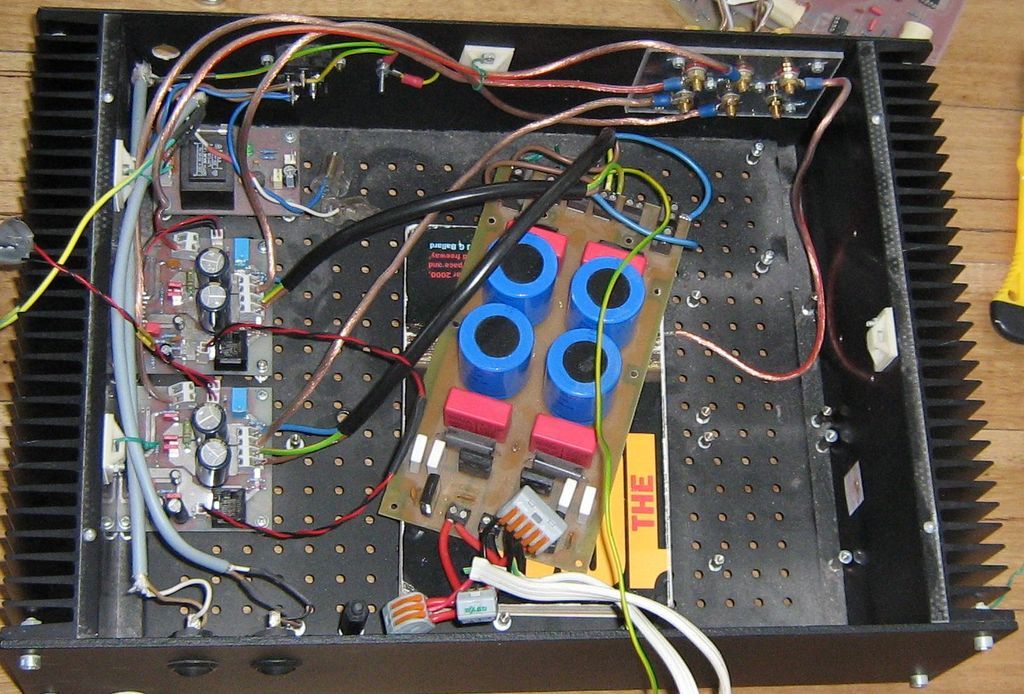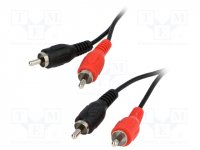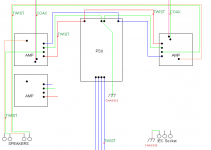Ready made cables are so cheap it is not worth making your own. For RCA, I use those very cheap interconnects that come with audio equipment. Cut off the connector at one end and connect it to the board. The cable can also be used for the internal input wiring.
Concerning the hum when the input is open. All the amps will be permanently connected to the crossover so the inputs will never be open. Possibly a problem that does not need to be fixed. The cause could be the layout of the amp board. Like twisting leads, it is important that the input and the return do not form a loop.
Concerning the hum when the input is open. All the amps will be permanently connected to the crossover so the inputs will never be open. Possibly a problem that does not need to be fixed. The cause could be the layout of the amp board. Like twisting leads, it is important that the input and the return do not form a loop.
its quieter when they are connected to something and noise even happens, when I just connect the input of 2 amp boards.
The cheap audio interconnects don't have any shield?
I guess there needs to be a shielded connector on the amp and xover board. Then ground the shield to one board only. I think I redo the xover board, put one dedicated shield ground on that then goes onto the earth connection. The audio cable I just use a single strand, as the ground comes from the star point. There are some slightly better RCA cables, somewhere around 5 bucks
interestingly, put 100pf and 100 ohm parallel and connect that to shield ground and ground on the amp board is louder than a twisted cable, when the other end is not connected and quieter than a twisted cable when both ends when connected. But the buzz is still annoying.
The cheap audio interconnects don't have any shield?
I guess there needs to be a shielded connector on the amp and xover board. Then ground the shield to one board only. I think I redo the xover board, put one dedicated shield ground on that then goes onto the earth connection. The audio cable I just use a single strand, as the ground comes from the star point. There are some slightly better RCA cables, somewhere around 5 bucks
interestingly, put 100pf and 100 ohm parallel and connect that to shield ground and ground on the amp board is louder than a twisted cable, when the other end is not connected and quieter than a twisted cable when both ends when connected. But the buzz is still annoying.
Last edited:
I would use shielded for all signal wires. If you really want to go to town use twisted pair shielded with screen and one off the pair to signal return at crossover end and shield not connected at amp. If using single screened wire connect screen at both ends
Ready made cables are so cheap it is not worth making your own. For RCA, I use those very cheap interconnects that come with audio equipment. Cut off the connector at one end and connect it to the board. The cable can also be used for the internal input wiring.
This is exactly what I usually do
aha, the cheap ones use the shield as ground. Found a somewhat more fancy video one, same thing. Somewhat thinner than an antenna cable, braided shield acting as ground. Ok, I make one up and hang it onto the mobile phone. Got a cheap one head phone to PCA.
Laptop, a bit worried, would have to run of battery and pull out the plug to 240V to be sure.
Laptop, a bit worried, would have to run of battery and pull out the plug to 240V to be sure.
its quieter when they are connected to something and noise even happens, when I just connect the input of 2 amp boards.
this statement makes it clear that a loop is being created so reviewing your ground scheme is in order.
the other thing to consider is isolating the signal lines between the amps(as well as the x-over) with either repeat coils (transformers) or opto isolators.
Make your own EMI measurement probes | Electronics Repair And Technology News
this sounds fun, reduce the source and get the wiring sorted.
I found set up 3 star points and then connect them via 100ohm and 100pf caps. But first I guess eliminate anything else. First I tried the other way, putting resistors on the outputwhile the noise was there and the noise did not change. But could also have been, the noise was too loud to hear the other influences.
this sounds fun, reduce the source and get the wiring sorted.
I found set up 3 star points and then connect them via 100ohm and 100pf caps. But first I guess eliminate anything else. First I tried the other way, putting resistors on the outputwhile the noise was there and the noise did not change. But could also have been, the noise was too loud to hear the other influences.
Have you replaced the three broken TDA's? If so we can try adding a second channel. Otherwise we could try connecting the crossover to the working amp.
ok, hooked up the phone, and its all quiet. Just with a butchered up 2 buck shop RCA to headphone cable. Leave the cable open, its more a hum. Quite big on the 50 Hz, not many overtones. Have to try again, when I connected two amp inputs, I hope I only connected the signal side. Otherwise its obviously a ground loop.
Only got 15 mins to edit post....
Haven't replaced the broken TDAs, can try the working amp.
For now its all star ground though, everything goes onto one gound, then onto the earth prong of the 3 pole socket
Or better pull out one of the PCBs and stick it into this amp? Or I try replacing a TDA, just get a 2nd one working for now.
Only got 15 mins to edit post....
Haven't replaced the broken TDAs, can try the working amp.
For now its all star ground though, everything goes onto one gound, then onto the earth prong of the 3 pole socket
Or better pull out one of the PCBs and stick it into this amp? Or I try replacing a TDA, just get a 2nd one working for now.
Last edited:
I think the inputs should only have the signals connected, otherwise there will be a ground loop. I reckon I will replace one blown up TDA and keep going with this setup, if I switch amps now, too many variables.
The signal input is a two wire connection. You must maintain continuity of that two wire connection otherwise you break the signal.
It comes down to remembering that any current from a source MUST return to it's source.
It comes down to remembering that any current from a source MUST return to it's source.
but when I just interconnect 2 amps, there should not be a signal? Thats why I am abit conderned about a ground loop, as the power crounds meet at the PSU.
Replaced 2 TDAs and tested the boards, see how it goes tomorrow
Replaced 2 TDAs and tested the boards, see how it goes tomorrow
sure enough it hums, with a twisted cable.
Could try same thing with a dismembered RCA cable
Earth is still not connected to the housing and nothing else, still coming direcrly from the socket in the wall.

Could try same thing with a dismembered RCA cable
Earth is still not connected to the housing and nothing else, still coming direcrly from the socket in the wall.

Take the speaker return back to star ground, not pcb. You've got too many unscreened wires. It looks like you've connected the inputs together? Don't do that. Try connecting signal return to the chassis
Last edited:
this would be the easiest way to eliminate anything else like the crossover. So now its either a groundloop or interference. If I only run the signal cable and disconnect the ground between the inputs, its same as loud, even with a way shorter cable. That only leaves interference. So I guess I have to try shielded.
Reducing the amplification helped as well, but that does not solve the problem.
Reducing the amplification helped as well, but that does not solve the problem.
Last edited:
There should be no voltage/signal difference between the case and the signal return. The only way to do this is to connect them together, ultimately at the rca socket when you have fitted it, but for the time being connect a wire between signal return and chassis anywhere convenient. Do this for all signal returns. The earth connection to chassis is for safety, nothing else.
Last edited:
essentially everything goes onto one star ground at once? Signal and power?
I still should try Marks picture further up, use cheap RCA cable first and then coax.
I still should try Marks picture further up, use cheap RCA cable first and then coax.
- Home
- Amplifiers
- Chip Amps
- how to get rid of interferences-TDA7293

